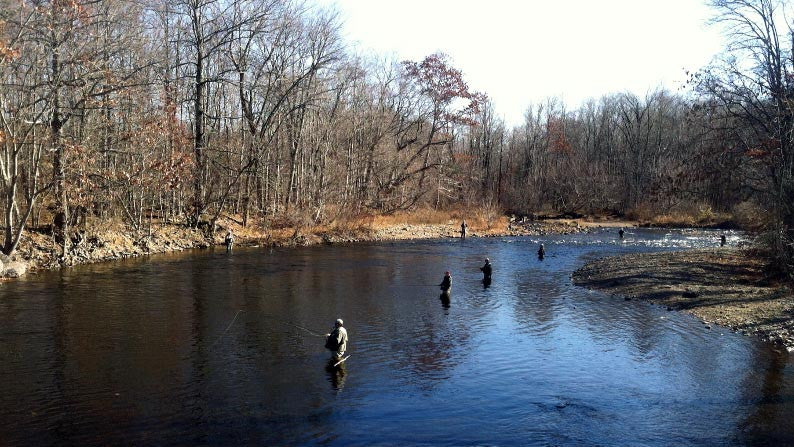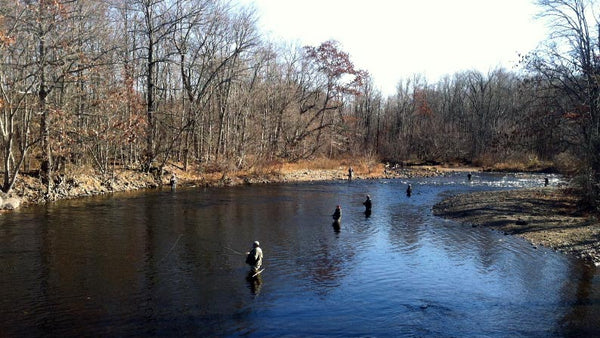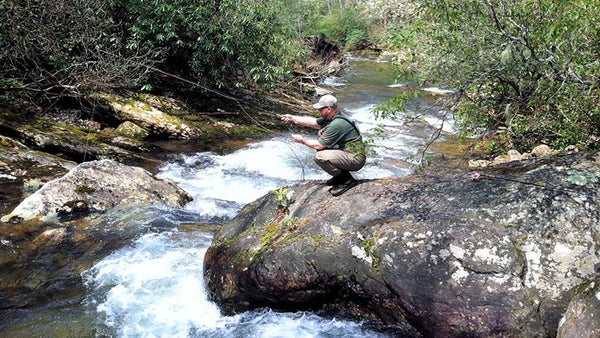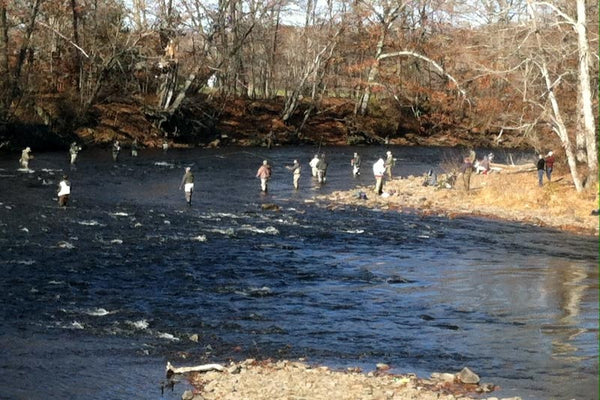Fly fishing etiquette: 6 easy things to consider when fishing in a crowd.


How close is too close?
I've been fishing for lake-run-salmonid species for many years. The excitement and draw of being able to possibly land a 20-plus-pound fish in the tight quarters of a tributary can be all-consuming.
With this desire also comes huge throngs of anglers, all in the hunt to thump their primal chests with a leviathan trophy.
I can recall years in the early 1990s where an entire winter steelheading class of 14 student-anglers could fish a small half-mile stretch of stream in a county park in Rochester, NY without feeling like we were taking over the neighborhood. And we caught fish!
Nowadays it seems there are fewer fish and more anglers. Attitudes have changed as well. The level of barbarianism and disrespect have escalated to alarming levels. Camaraderie has turned to urban-redneck-thug-clans. We seemed to have devolved to less-than-caveman qualities. It's great to fish with friends, but many times it's difficult to fish side by side and have an enjoyable experience.
Angler overcrowding and fishing pressure aren't limited to just weekends. Any given weekday can look like a Saturday during peak salmon season.
With this overcrowding comes the question of how close is too close to fish next to someone?
Here are 6 easy things to consider when someone is occupying water you think holds fish.
1. Stop and watch from a distance.
Analyze how the person is fishing.
Are they camped out on one spot, and not moving? Nothing says fun like fishing the same exact spot over and over for hours on end (heavy sarcasm here).
Are they casting upstream, are they drifting an indicator, are they using spinning gear, are they swinging streamers, are they using bait, etc.?
2. Put yourself in their wading boots.

Is there room for you to fish effectively next to the person?
Would you be annoyed if you switched roles with this person and they were looking to fish next to you?
3. Make your approach.
Once you've determined that it might be worth squeezing in, make your approach with eye contact and a simple greeting.
This is the best way to judge the mood of the person.
Failure to acknowledge a simple greeting can be an indicator to move elsewhere. If you're not sure the person heard you, try a different approach and ask how the fishing is.
4. Ask if it's okay to fish either above or below them.

This can be tricky. If they're drifting downstream, don't ask to fish directly below them. Use common sense.
During the height of the salmon run a couple of years ago, I watched a fellow angler fishing stationary in a spot. He was clearly fishing downstream, and I made my approach to fish above him.
He looked at me, and I quickly said, "Hello, how are you?"
His response was, "Who the #@*% are you?"
My response was, "Vern, who the #@*% are you?"
From there we laughed and talked about the fishing, and fished together for the next hour or so.
Although I thought it was going to be an unpleasant experience, it quickly became memorable just from the initial greeting. Needless to say, neither of us caught any fish.
I've also had anglers not respond to any greeting or effort to communicate at all. This, to me, is a free invitation to fish near them, but still be mindful of personal space.
5. Slot in.
Is there an actual distance that you should space yourself from another angler on pressured waters?
Here's something to consider. Ever have a close talker? You know, the person who tends to invade your personal space when talking to you and makes you feel uncomfortable.

My rule of thumb is 2 rod-lengths away if fishing above someone, and 3 if fishing below. This is a crude measurement, but a starting point to work with. If fishing upstream from an angler, your drift should not be ending in front of him.
I've had an angler fishing above who would end his drift, right in front of me. I could see his fly every drift directly in front of me. The only thing he was going to catch was my waders.
The most difficult scenario is trying to fit between 2 anglers. Inevitably, you're going to crowd someone out, and potentially cross lines.
This is the perfect indicator that you're fishing too close to someone. Line crossing is not uncommon, but if you're having line crossing issues ever few casts, then someone needs to move elsewhere.
This can hold true for anglers fishing the opposite bank as well.
Most of what I've discussed so far is angler spacing on the same side of the stream.
Now picture a smaller tributary where the angler on the other side of the stream doesn't really need to ask whether he can fish above or below you.
The issue here is oftentimes people are sure they need to cast directly in front of where you're standing.
Forget about where you are fishing...Where you're standing!
I've seen this countless times. An angler casting across the stream and his bait and weight land directly in front of me.
Line crossing and disrespect are sure to cause trouble in this situation. Anglers tend to be a whole lot braver when a stream is dividing the two of them.
I've seen plenty of line crossings, where the angler on one side reels in the tangle and simply cuts the line of the other angler and sends the limp line back. Thus, the feud begins.
Most of us fish to get away and relax, not get into a verbal altercation over space.
In recent years, I've heard of knives being pulled, and yes, a shirt lifted to show the handle of a gun, on anglers who are fishing all too close.
All this for a fish?! I think not!
There is nothing more disappointing than to think that a weapon is needed to fish public waters.
My rule is this: If you can't find room to fish, move elsewhere!
Discover new areas, find that secret spot – pressured fish often seek out non-typical places to hide.
If nothing else, sit back and watch the rat race of people trying to catch that trophy fish. It really can be like the circus coming to town.
6. Don't camp out.

Once allowed into a spot, fish it respectfully, quickly, and say thank you.
Don't camp out! If you aren't catching anything, move on to find more water.
Many anglers, especially those of us who swing flies, try to rotate through a run or pool.
Everyone keeps working down through the stretch, giving all the anglers a chance to fish the entire stretch. It can be just as much fun watching someone connect with a fish as it is to be the one getting the line tug.
As with any angling, patience pays off and eventually you'll connect with that fish of a lifetime.
Remember, the journey getting there can be as memorable as the catching.
Want more articles like this?
Join the Flymen Mailing List at the bottom of the page!
About VERN-O Burm:
 LeVern "VERN-O" Burm has been fly fishing for 15+ years, and fly tying for nearly as long. He's lived in the upstate New York area his entire life and fishes the Finger Lakes, Great Lakes, Catskills, Adirondacks, and all the waterways in between. Fly tying soon developed from a hobby to a passion, and eventually into a side business, Custom Flies By VERN-O. He's been tying commercially for 5+ years. His love of tying comes from a background in science and art. He puts his heart and creativity into his fly tying, and what he produces at the vise is an extension of what drives him from inside. VERN-O enjoys tying soft hackle flies and fishable spey flies, but also dabbles outside these realms as well. He has a fondness for chasing steelhead and fish that swim. Follow him on Facebook, Instagram, and Twitter.
LeVern "VERN-O" Burm has been fly fishing for 15+ years, and fly tying for nearly as long. He's lived in the upstate New York area his entire life and fishes the Finger Lakes, Great Lakes, Catskills, Adirondacks, and all the waterways in between. Fly tying soon developed from a hobby to a passion, and eventually into a side business, Custom Flies By VERN-O. He's been tying commercially for 5+ years. His love of tying comes from a background in science and art. He puts his heart and creativity into his fly tying, and what he produces at the vise is an extension of what drives him from inside. VERN-O enjoys tying soft hackle flies and fishable spey flies, but also dabbles outside these realms as well. He has a fondness for chasing steelhead and fish that swim. Follow him on Facebook, Instagram, and Twitter.


I recently had an unfortunate encounter with a disrespectful angler while I was filming o. The stream. You can listen to the exchange here.
https://troutstrike.com/what-happened-to-fly-fishing-etiquette/
Thanks Vern-O for good and interesting advice.
Pat May
Donegal
Ireland
Thank you for the article. I look forward to reading more. 🎣👍😊
From the wilds of Robs Michigan…🌲🌲
Good read-thanks! Now how about boats and wading fishers etiquette:)
I’m sorry but Amy Hazel up there is ridiculous. There is no need to be a football field or two away from someone to fish.
Leave a comment